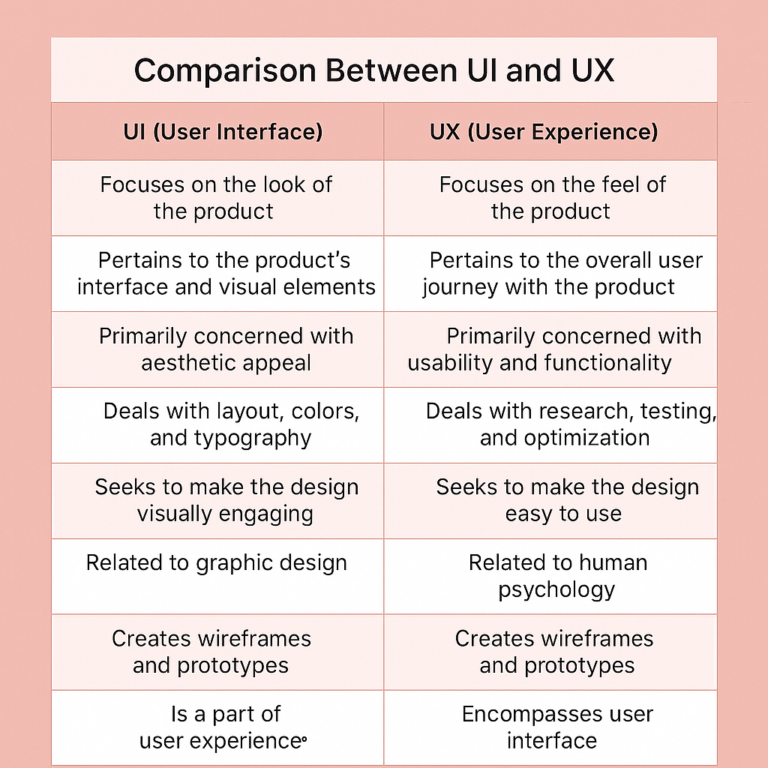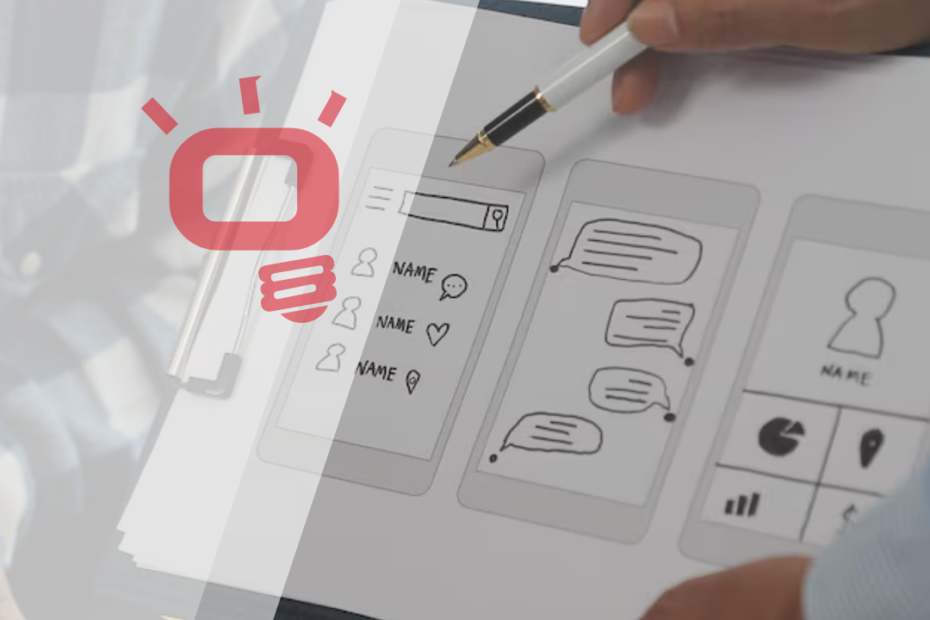Creating exceptional digital experiences depends on more than just good aesthetics. UI UX design have become core components of any successful product team. Employers today seek designers who blend creativity, empathy, and technical proficiency. Here’s what you need to know about the skills in demand and how UI and UX professionals contribute to creating seamless user journeys.
What is UI Design?
UI design refers to the process of designing the visual layout and interactive elements of a digital product. It focuses on the aesthetics and functionality of a user interface. Key elements include:
Buttons and icons: The interactive components that users click or tap.
Typography: The style, size, and spacing of text for clarity and branding.
Color schemes: The palette used to create harmony and emphasize elements.
Layout and spacing: Structuring content to guide user attention effectively.
Responsive behavior: Ensuring consistency across various screen sizes.
UI design bridges the gap between complex technical functionality and the user, creating a familiar and engaging experience.
What Do UI Designers Do?
A UI designer is responsible for crafting the look and feel of a product interface. Their key responsibilities include:
Creating high-fidelity mockups that reflect the product’s visual identity.
Developing design systems to ensure consistency across all screens.
Collaborating with developers to translate designs into code accurately.
Applying branding guidelines to interfaces while maintaining usability.
Conducting UI audits to refine and optimize visual components.
UI designers focus on clarity, aesthetics, and usability to build interfaces that users enjoy.
What Skills Do UI Designers Need?
Employers look for UI designers who demonstrate proficiency in visual and technical design. Important skills include:
Design software mastery: Figma, Sketch, Adobe XD, and InVision.
Visual design principles: Layout, spacing, color theory, and typography.
Responsive design: Adapting layouts for mobile, tablet, and desktop.
Accessibility awareness: Creating inclusive designs for all users.
Attention to detail: Maintaining pixel-perfect alignment and clarity.
Collaboration: Working effectively with UX teams, developers, and stakeholders.
What is UX Design?
UX design focuses on the user’s overall experience when interacting with a product. It goes beyond visuals to address usability, functionality, and emotional satisfaction. Core components include:
User research: Understanding user needs and behaviors.
User personas: Profiles that represent key user groups.
Wireframes and flows: Visual maps of user paths and interface structure.
Prototypes: Interactive mockups to simulate experiences.
Usability testing: Gathering feedback to improve designs.
The goal of UX design is to deliver intuitive, efficient, and satisfying user interactions.
What Do UX Designers Do?
A UX designer ensures the usability and functionality of a product through research, analysis, and testing. Their tasks include:
Conducting user research to gather insights.
Creating user journey maps that highlight pain points.
Designing wireframes and prototypes to plan and test user flows.
Running usability tests to validate design decisions.
Iterating on feedback to improve experiences over time.
UX designers focus on building experiences that are not only functional but delightful and user-centered.
What Are the Different Types of UX?
UX design can be broken into several specialized areas:
Interaction Design (IxD): Focuses on user actions and system responses.
Information Architecture (IA): Organizes and structures content logically.
UX Research: Gathers data to inform design choices.
Usability Testing: Identifies issues and areas for improvement.
UX Writing: Crafts clear, concise interface content.
Service Design: Maps the broader user experience across platforms and touchpoints.
What Skills Do UX Designers Need?
Successful UX designers bring a diverse set of skills to the table, including:
Empathy: Understanding user motivations and challenges.
Research methods: Interviews, surveys, analytics, and A/B testing.
Wireframing and prototyping: Tools like Balsamiq, Figma, and Axure.
Analytical thinking: Translating data into actionable design strategies.
Communication: Presenting findings and collaborating with teams.
Iteration: Rapidly refining designs based on user feedback.
What’s the Difference Between UI and UX?
UI and UX serve different but complementary roles:
UI = Appearance: Focuses on visual design and interactive elements.
UX = Experience: Focuses on usability, logic, and problem-solving.
Together, they create seamless, attractive, and intuitive products.

What is a UI UX Designer?
A UI UX designer merges both disciplines into one role. They are responsible for:
Researching user needs and mapping user journeys.
Creating wireframes and prototypes for usability testing.
Designing final UI elements based on findings.
Collaborating across departments to ensure a unified vision.
This role is common in startups or small teams where one designer handles the full design cycle.
How Do UI UX Design Work Together?
UI and UX work in parallel:
UX defines the structure and logic.
UI brings it to life with visual polish.
Both continuously iterate based on feedback.
Their collaboration ensures products are both practical and visually compelling.
How To Test UI UX Design Skills?
Employers assess UI UX skills through various methods to understand a candidate’s approach to problem-solving, creativity, collaboration, and technical proficiency. Here are common approaches:
Portfolio Reviews: Candidates present past projects, walking through their design process, user research, wireframes, visual design, and final outcomes. Recruiters look for strategic thinking, consistency, and design decisions tied to user or business goals.
Design Challenges: Timed or take-home assignments that simulate real-world problems. Tasks may include designing a mobile onboarding screen, improving a checkout flow, or developing wireframes for a dashboard. Employers evaluate usability, aesthetics, and justification of choices.
Whiteboard or Live Design Sessions: In interviews, designers are asked to think aloud while sketching or wireframing on a whiteboard or in a collaborative design tool like Figma or Miro. This tests communication, logic, and creativity under pressure.
Critique Exercises: Reviewing existing interfaces (e.g., a popular app or the company’s own product) and suggesting improvements based on usability, accessibility, and aesthetics.
User Testing Simulation: Some companies simulate a usability test scenario and ask candidates how they would set up the test, interpret results, and implement changes.
Tool Proficiency: Candidates may be assessed on how efficiently they use design software such as Figma, Sketch, Adobe XD, or prototyping and handoff tools like Zeplin or InVision.
Team Collaboration Scenarios: Testing soft skills through hypothetical situations like resolving design-developer conflicts, handling tight deadlines, or adapting based on client feedback.
Problem Solving Case Studies: Asking candidates to describe how they resolved a real design problem, what constraints they faced, what trade-offs they made, and how they measured success.
Ultimately, the goal of testing is not just to assess design ability, but also mindset, user empathy, adaptability, and how well the designer can contribute to a product team.
What is the Salary of a UI UX Designer?
UI UX salaries depend on location, experience, and role type:
Entry-level: $55k – $75k/year (U.S.)
Mid-level: $75k – $105k/year
Senior: $105k – $150k+/year
Freelancers: $30 – $150/hour based on expertise
Global remote roles and industry demand have increased earning potential.
FAQs About UI UX Design
Do I need a degree to become a UI UX designer?
No, many succeed via bootcamps, self-learning, or related fields.
Can one person do both UI and UX?
Yes, especially in smaller teams. Larger companies may hire separately.
Is coding necessary for UI UX designers?
Not essential, but front-end basics (HTML/CSS/JS) are helpful.
How can I build a strong portfolio?
Include case studies showing problem-solving, research, and final results.
What industries hire UI UX designers?
Tech, healthcare, fintech, education, e-commerce — almost every digital domain.
What are some common tools used by UI UX designers?
Figma, Sketch, Adobe XD, InVision, Balsamiq, Axure, Miro, and usability testing tools like Maze and Lookback.
How long does it take to become a UI UX designer?
Depending on your learning path, it can take 3–12 months through a bootcamp or up to 4 years with a university degree.
What is the difference between wireframes and prototypes?
Wireframes are static blueprints of layout and structure, while prototypes are interactive models that simulate user flow and behavior.
How do I stay updated on UI UX trends?
Follow design blogs (like Smashing Magazine, UX Collective), attend webinars, join communities (like Dribbble, Behance, UX Mastery), and subscribe to newsletters.
What is a design system and why is it important?
A design system is a collection of reusable components, guidelines, and standards that ensure consistency and scalability in product design.
No, many succeed via bootcamps, self-learning, or related fields.
Can one person do both UI and UX?
Yes, especially in smaller teams. Larger companies may hire separately.
Is coding necessary for UI UX designers?
Not essential, but front-end basics (HTML/CSS/JS) are helpful.
How can I build a strong portfolio?
Include case studies showing problem-solving, research, and final results.
What industries hire UI UX designers?
Tech, healthcare, fintech, education, e-commerce almost every digital domain.
